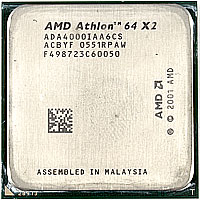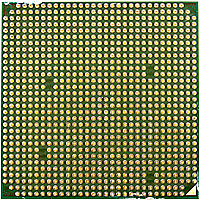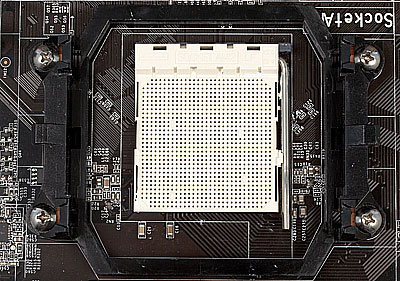 |
||
|
||
| ||
New platform in briefThe new platform from AMD is actually a well-known old one with the only difference - a new memory controller in the processor: it now supports DDR2 (from DDR2-400 to DDR2-800). As you can see on the photo, it has absolutely no effect on the CPU exterior (reverting to 940 pins, like in the first Athlon 64 FX models for the server socket, is hardly a major modification).  
The first motherboard to arrive at our lab was MSI K9N SLI Platinum based on the latest NVIDIA nForce 570 SLI chipset. It looks quite usual, but for DDR2-800 memory used together with a typically AMD socket :).  The socket itself has a slightly modified CPU retention mechanism — there disappeared side stops, which did not let the heatsink to shift sideways, and the number of cooler hooks is reduced from three to one (per each side). Thus, if we do not take into account that the hooks are attached not to the socket, but to a special binding screwed to the motherboard, the new retention mechanism resembles... Socket A or Socket 370. I don't know what inspired AMD engineers to "Back to the future". However, coolers for Socket 754/939/940 can be installed on the new socket (even if with some effort) and work well. We have also seen for the first time a connector for a 4-pin PWM cooler on a motherboard for AMD. To all appearances, AMD decided to "catch up with Intel in all respects" in the new platform :).  There is nothing sensational in other respects. Just a usual Athlon 64 processor, but with a new socket and support for another memory type. At the same time, the qualitative advance is quite noticeable: two DDR2-800 channels versus two DDR-400 channels — that's (in pure theory) a twofold advantage in bandwidth! Well, we'll see how our tests will react to it... Hardware and SoftwareTestbed configurations
* — "2x..." means "per each core" As Athlon 64 X2 4000+ has no direct opponent (Athlon 64 X2 3800+ has half as much cache memory and Athlon 64 X2 4400+ operates at a higher clock), we decided to decrease the multiplier to ten in a regular Athlon 64 FX-60. Thus, we get exactly the same dual-core processor as Athlon 64 X2 4000+ for Socket AM2, only for Socket 939. In our opinion, it will be the best posed comparison from the point of view of evaluating advantages of the new platform. Besides, you might have already noticed that the list of test participants does not include Intel processors. It seems logical, as you may read, for example, Testing Athlon 64 FX-60 to learn performance results of various Intel NetBurst-based CPU families and AMD flagships. This comparison should be enough. It would be really interesting to compare the new platform from AMD with Intel "Conroe". But alas, we still haven't got it in our lab. Software
Drivers
Necessary preface to the diagramsOur test procedure features two peculiarities of data representation: (1) all data types are reduced to one — integer relative score (performance of a given processor relative to Pentium D 805, if its performance is taken for 100 points), and (2) detailed results are published in a table in Microsoft Excel format, while the article contains only summary diagrams for benchmark classes. 3D Modeling and Rendering
CAD (computer-aided design) Compile
RightMark Project
Processing Bitmap Images (Photos)
WEB server
Answer One: the point is in CPU clocks. Huge memory bandwidth, provided by the dual-channel DDR2-800 controller for the Athlon 64 X2 4000+ processor is just... wasted. It cannot operate fast enough to load such high-speed memory. That's why we can see practically no difference between Athlon 64 FX-60 @ 2000 MHz + DDR-400 and Athlon 64 X2 4000+ + DDR2-800. Athlon 64 FX-62, which clock is higher by 800 MHz, is quite another matter. In this case, DDR-400 (for FX-60) becomes a bottleneck, it does not allow a processor to reveal its full performance potential. But the FX-62 with dual-channel DDR2-800 is not limited in this way — that's why it outperforms FX-60 so much that it cannot be explained by the clock advantage only. Answer Two: a system with Athlon 64 X2 4000+ actually worked with DDR2-400 memory (533, 667...) instead of DDR2-800. As Dmitri Besedin already wrote in his article, devoted to a detailed analysis of the new Athlon 64 memory controller, there is no accurate way to find out at what frequency memory actually operates. We can only trust the value specified in BIOS Setup. File Packing
Audio Encoding
Video Encoding
OCR 3D Shooter Games Total scoreConclusionI repeat: nothing extraordinary has happened. Thank God :). AMD currently takes the "little and often fill the purse" stand: sometimes it slightly increases the core clock, sometimes it introduces SSE3 support or merges two cores into a single processor, or masters DDR2 (800 at that). Why should it bustle? Frankly speaking, it's the main competitor who must be bustling now. AMD is doing great anyway. At least in terms of CPU performance. Durability of the K8 core and its capacity to adapt to new market realia is admirable: having lived without major modifications through two process technologies, dual cores, and now a new memory controller, this core meticulously responds to each improvement with performance gains. We were very skeptic about future chances of the new AMD platform against the new processor core from Intel (Intel designed the new core nearly from scratch, while AMD K8 is rather old), but our tests warmed up our interest. The situation may turn out not that simple. At least, Intel Conroe will have a worthy opponent, especially as it also has some drawbacks to fix: according to our previous review, the DDR2 controller in new AMD processors is not perfect yet. Memory modules for our testbeds are kindly provided by
Russian representatives of Corsair Memory Stanislav Garmatiuk (nawhi@ixbt.com) May 23, 2006 Write a comment below. No registration needed!
|
Platform · Video · Multimedia · Mobile · Other || About us & Privacy policy · Twitter · Facebook Copyright © Byrds Research & Publishing, Ltd., 1997–2011. All rights reserved. |